Advanced Business Analysis Report on OKLG Program Analysis
VerifiedAdded on 2021/06/17
|14
|2286
|145
Report
AI Summary
This report provides an in-depth analysis of the OKLG program, focusing on advanced business analysis techniques. It begins with an exploration of elicitation and collaboration, outlining main objectives and business requirements, including creating efficient models and data structures. The report then delves into user requirements and assumptions, followed by a detailed examination of requirements analysis and design definition, including the application of a new social care system and designing information systems. The report also addresses performance measures, such as user satisfaction, average response time, and error rates, along with a risk management mitigation plan. The analysis includes the application of performance measures to avoid business risks and ensure the success of the OKLG program. The report concludes with references to relevant literature and supporting appendices.
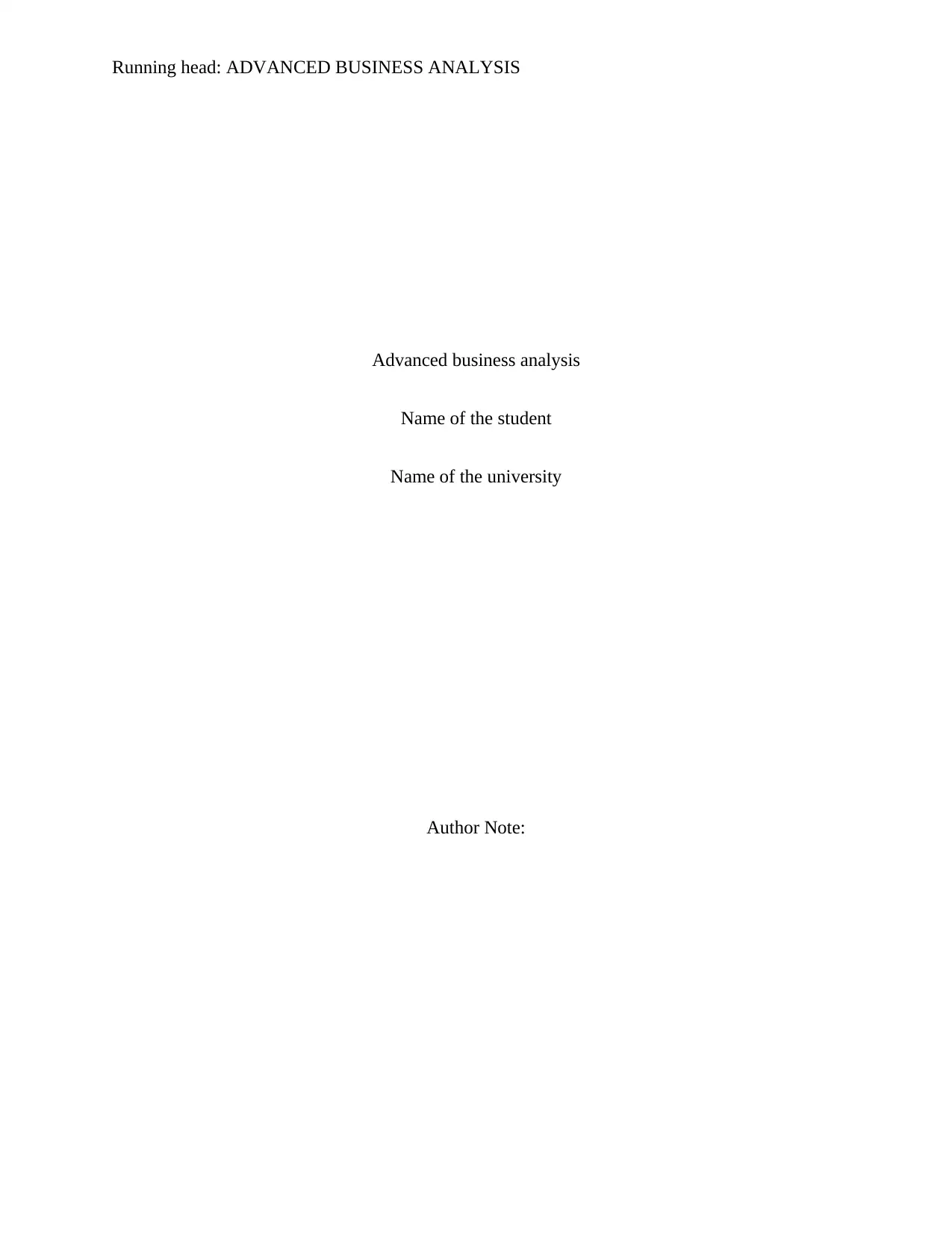
Running head: ADVANCED BUSINESS ANALYSIS
Advanced business analysis
Name of the student
Name of the university
Author Note:
Advanced business analysis
Name of the student
Name of the university
Author Note:
Paraphrase This Document
Need a fresh take? Get an instant paraphrase of this document with our AI Paraphraser
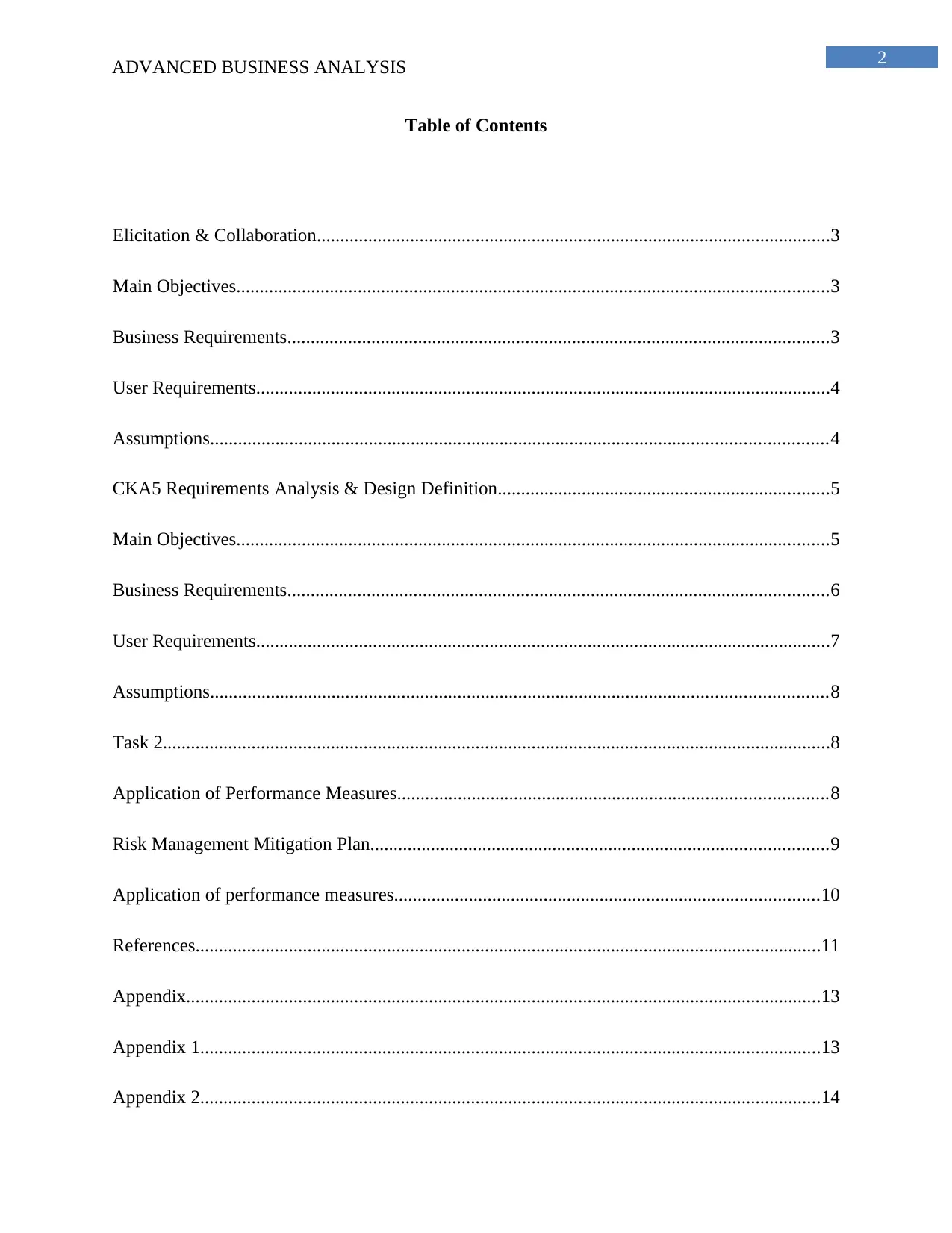
2
ADVANCED BUSINESS ANALYSIS
Table of Contents
Elicitation & Collaboration..............................................................................................................3
Main Objectives...............................................................................................................................3
Business Requirements....................................................................................................................3
User Requirements...........................................................................................................................4
Assumptions....................................................................................................................................4
CKA5 Requirements Analysis & Design Definition.......................................................................5
Main Objectives...............................................................................................................................5
Business Requirements....................................................................................................................6
User Requirements...........................................................................................................................7
Assumptions....................................................................................................................................8
Task 2...............................................................................................................................................8
Application of Performance Measures............................................................................................8
Risk Management Mitigation Plan..................................................................................................9
Application of performance measures...........................................................................................10
References......................................................................................................................................11
Appendix........................................................................................................................................13
Appendix 1.....................................................................................................................................13
Appendix 2.....................................................................................................................................14
ADVANCED BUSINESS ANALYSIS
Table of Contents
Elicitation & Collaboration..............................................................................................................3
Main Objectives...............................................................................................................................3
Business Requirements....................................................................................................................3
User Requirements...........................................................................................................................4
Assumptions....................................................................................................................................4
CKA5 Requirements Analysis & Design Definition.......................................................................5
Main Objectives...............................................................................................................................5
Business Requirements....................................................................................................................6
User Requirements...........................................................................................................................7
Assumptions....................................................................................................................................8
Task 2...............................................................................................................................................8
Application of Performance Measures............................................................................................8
Risk Management Mitigation Plan..................................................................................................9
Application of performance measures...........................................................................................10
References......................................................................................................................................11
Appendix........................................................................................................................................13
Appendix 1.....................................................................................................................................13
Appendix 2.....................................................................................................................................14
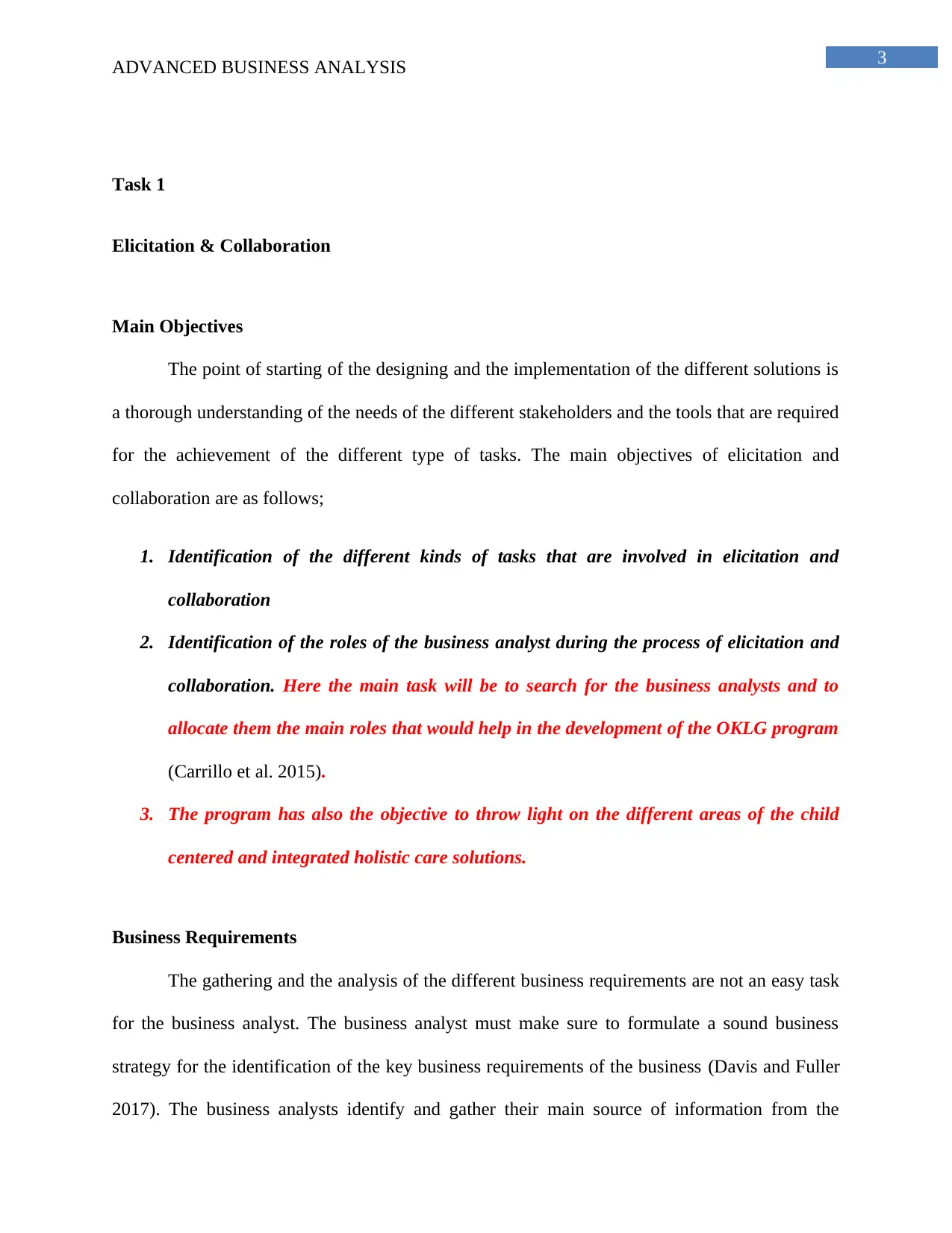
3
ADVANCED BUSINESS ANALYSIS
Task 1
Elicitation & Collaboration
Main Objectives
The point of starting of the designing and the implementation of the different solutions is
a thorough understanding of the needs of the different stakeholders and the tools that are required
for the achievement of the different type of tasks. The main objectives of elicitation and
collaboration are as follows;
1. Identification of the different kinds of tasks that are involved in elicitation and
collaboration
2. Identification of the roles of the business analyst during the process of elicitation and
collaboration. Here the main task will be to search for the business analysts and to
allocate them the main roles that would help in the development of the OKLG program
(Carrillo et al. 2015).
3. The program has also the objective to throw light on the different areas of the child
centered and integrated holistic care solutions.
Business Requirements
The gathering and the analysis of the different business requirements are not an easy task
for the business analyst. The business analyst must make sure to formulate a sound business
strategy for the identification of the key business requirements of the business (Davis and Fuller
2017). The business analysts identify and gather their main source of information from the
ADVANCED BUSINESS ANALYSIS
Task 1
Elicitation & Collaboration
Main Objectives
The point of starting of the designing and the implementation of the different solutions is
a thorough understanding of the needs of the different stakeholders and the tools that are required
for the achievement of the different type of tasks. The main objectives of elicitation and
collaboration are as follows;
1. Identification of the different kinds of tasks that are involved in elicitation and
collaboration
2. Identification of the roles of the business analyst during the process of elicitation and
collaboration. Here the main task will be to search for the business analysts and to
allocate them the main roles that would help in the development of the OKLG program
(Carrillo et al. 2015).
3. The program has also the objective to throw light on the different areas of the child
centered and integrated holistic care solutions.
Business Requirements
The gathering and the analysis of the different business requirements are not an easy task
for the business analyst. The business analyst must make sure to formulate a sound business
strategy for the identification of the key business requirements of the business (Davis and Fuller
2017). The business analysts identify and gather their main source of information from the
⊘ This is a preview!⊘
Do you want full access?
Subscribe today to unlock all pages.

Trusted by 1+ million students worldwide
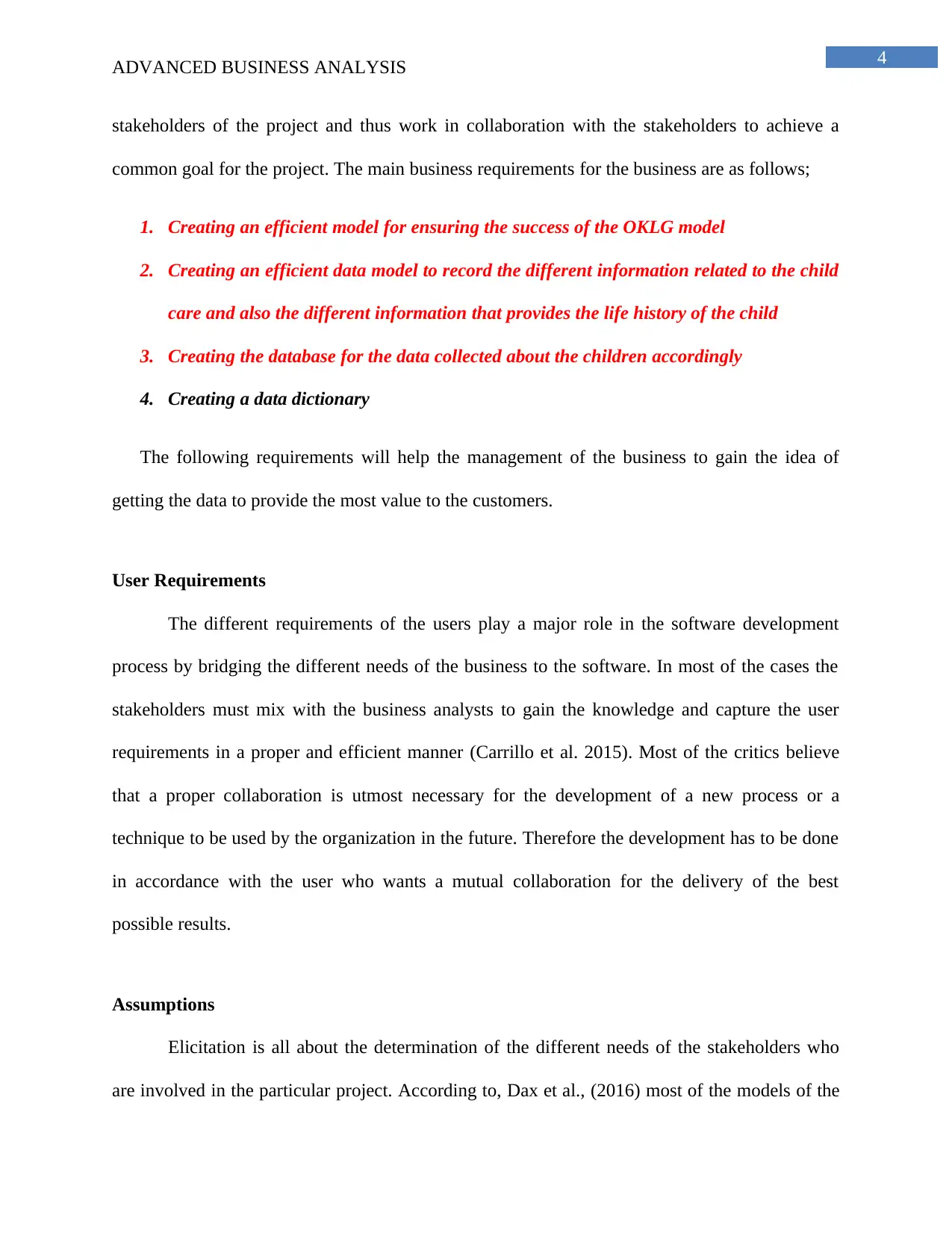
4
ADVANCED BUSINESS ANALYSIS
stakeholders of the project and thus work in collaboration with the stakeholders to achieve a
common goal for the project. The main business requirements for the business are as follows;
1. Creating an efficient model for ensuring the success of the OKLG model
2. Creating an efficient data model to record the different information related to the child
care and also the different information that provides the life history of the child
3. Creating the database for the data collected about the children accordingly
4. Creating a data dictionary
The following requirements will help the management of the business to gain the idea of
getting the data to provide the most value to the customers.
User Requirements
The different requirements of the users play a major role in the software development
process by bridging the different needs of the business to the software. In most of the cases the
stakeholders must mix with the business analysts to gain the knowledge and capture the user
requirements in a proper and efficient manner (Carrillo et al. 2015). Most of the critics believe
that a proper collaboration is utmost necessary for the development of a new process or a
technique to be used by the organization in the future. Therefore the development has to be done
in accordance with the user who wants a mutual collaboration for the delivery of the best
possible results.
Assumptions
Elicitation is all about the determination of the different needs of the stakeholders who
are involved in the particular project. According to, Dax et al., (2016) most of the models of the
ADVANCED BUSINESS ANALYSIS
stakeholders of the project and thus work in collaboration with the stakeholders to achieve a
common goal for the project. The main business requirements for the business are as follows;
1. Creating an efficient model for ensuring the success of the OKLG model
2. Creating an efficient data model to record the different information related to the child
care and also the different information that provides the life history of the child
3. Creating the database for the data collected about the children accordingly
4. Creating a data dictionary
The following requirements will help the management of the business to gain the idea of
getting the data to provide the most value to the customers.
User Requirements
The different requirements of the users play a major role in the software development
process by bridging the different needs of the business to the software. In most of the cases the
stakeholders must mix with the business analysts to gain the knowledge and capture the user
requirements in a proper and efficient manner (Carrillo et al. 2015). Most of the critics believe
that a proper collaboration is utmost necessary for the development of a new process or a
technique to be used by the organization in the future. Therefore the development has to be done
in accordance with the user who wants a mutual collaboration for the delivery of the best
possible results.
Assumptions
Elicitation is all about the determination of the different needs of the stakeholders who
are involved in the particular project. According to, Dax et al., (2016) most of the models of the
Paraphrase This Document
Need a fresh take? Get an instant paraphrase of this document with our AI Paraphraser
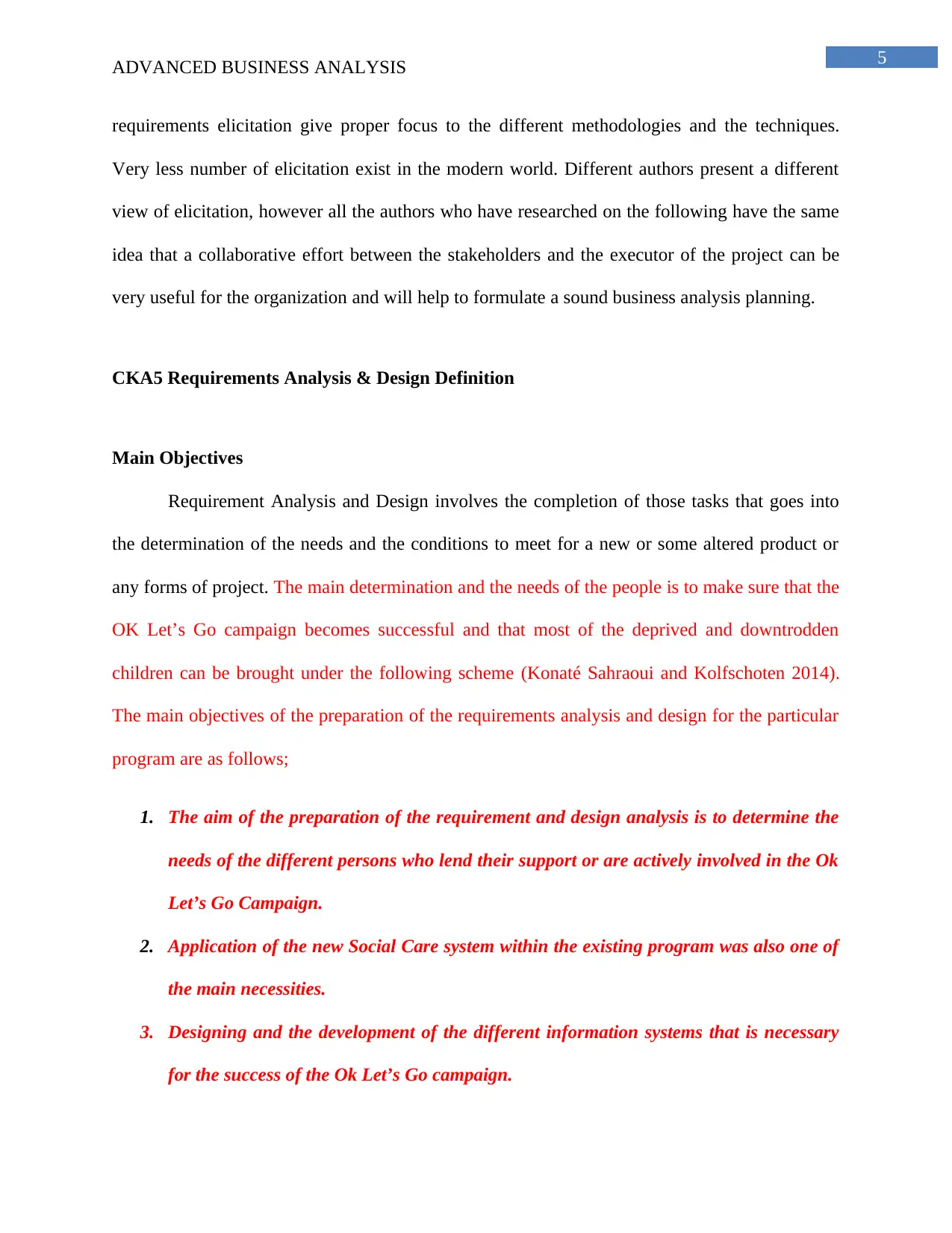
5
ADVANCED BUSINESS ANALYSIS
requirements elicitation give proper focus to the different methodologies and the techniques.
Very less number of elicitation exist in the modern world. Different authors present a different
view of elicitation, however all the authors who have researched on the following have the same
idea that a collaborative effort between the stakeholders and the executor of the project can be
very useful for the organization and will help to formulate a sound business analysis planning.
CKA5 Requirements Analysis & Design Definition
Main Objectives
Requirement Analysis and Design involves the completion of those tasks that goes into
the determination of the needs and the conditions to meet for a new or some altered product or
any forms of project. The main determination and the needs of the people is to make sure that the
OK Let’s Go campaign becomes successful and that most of the deprived and downtrodden
children can be brought under the following scheme (Konaté Sahraoui and Kolfschoten 2014).
The main objectives of the preparation of the requirements analysis and design for the particular
program are as follows;
1. The aim of the preparation of the requirement and design analysis is to determine the
needs of the different persons who lend their support or are actively involved in the Ok
Let’s Go Campaign.
2. Application of the new Social Care system within the existing program was also one of
the main necessities.
3. Designing and the development of the different information systems that is necessary
for the success of the Ok Let’s Go campaign.
ADVANCED BUSINESS ANALYSIS
requirements elicitation give proper focus to the different methodologies and the techniques.
Very less number of elicitation exist in the modern world. Different authors present a different
view of elicitation, however all the authors who have researched on the following have the same
idea that a collaborative effort between the stakeholders and the executor of the project can be
very useful for the organization and will help to formulate a sound business analysis planning.
CKA5 Requirements Analysis & Design Definition
Main Objectives
Requirement Analysis and Design involves the completion of those tasks that goes into
the determination of the needs and the conditions to meet for a new or some altered product or
any forms of project. The main determination and the needs of the people is to make sure that the
OK Let’s Go campaign becomes successful and that most of the deprived and downtrodden
children can be brought under the following scheme (Konaté Sahraoui and Kolfschoten 2014).
The main objectives of the preparation of the requirements analysis and design for the particular
program are as follows;
1. The aim of the preparation of the requirement and design analysis is to determine the
needs of the different persons who lend their support or are actively involved in the Ok
Let’s Go Campaign.
2. Application of the new Social Care system within the existing program was also one of
the main necessities.
3. Designing and the development of the different information systems that is necessary
for the success of the Ok Let’s Go campaign.
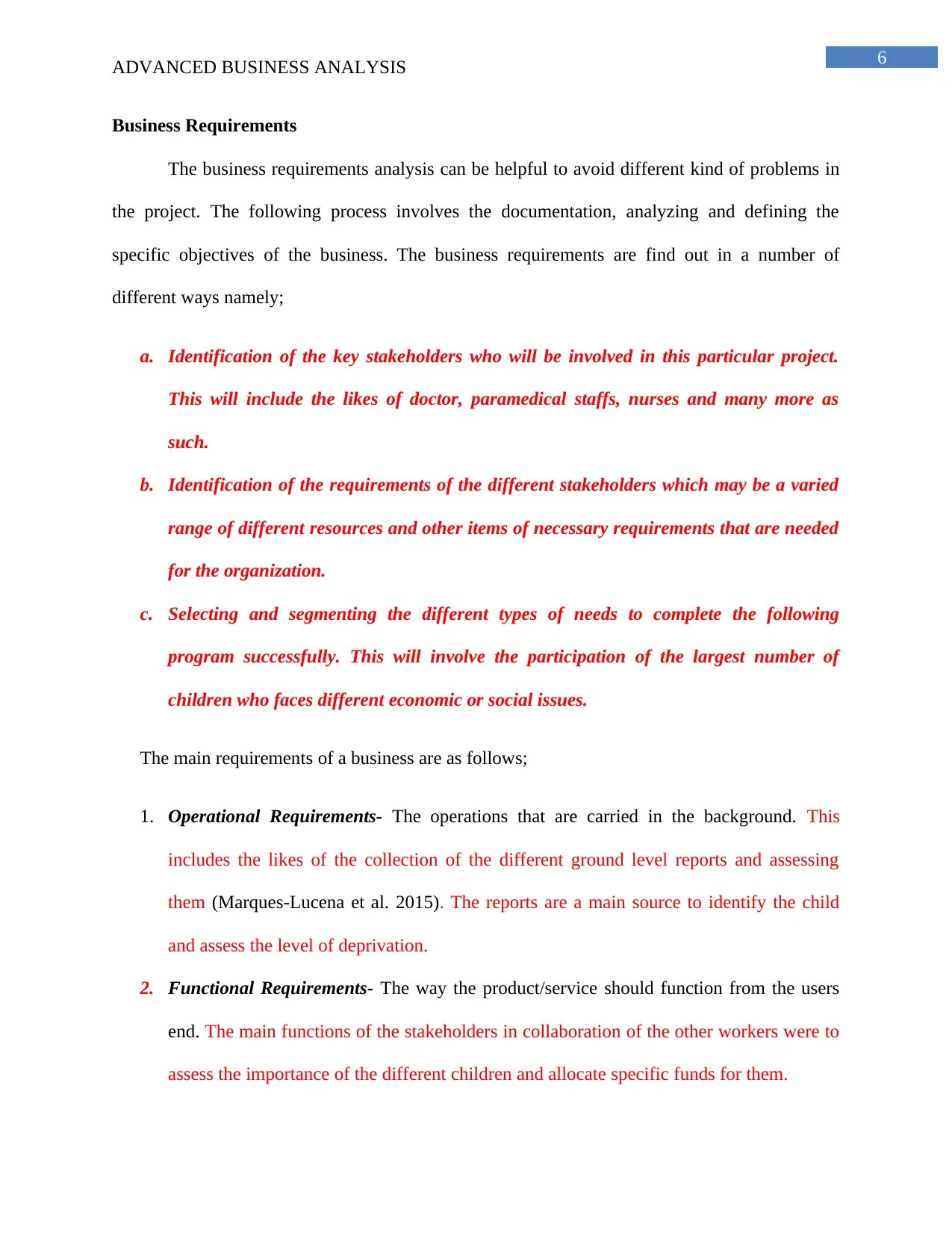
6
ADVANCED BUSINESS ANALYSIS
Business Requirements
The business requirements analysis can be helpful to avoid different kind of problems in
the project. The following process involves the documentation, analyzing and defining the
specific objectives of the business. The business requirements are find out in a number of
different ways namely;
a. Identification of the key stakeholders who will be involved in this particular project.
This will include the likes of doctor, paramedical staffs, nurses and many more as
such.
b. Identification of the requirements of the different stakeholders which may be a varied
range of different resources and other items of necessary requirements that are needed
for the organization.
c. Selecting and segmenting the different types of needs to complete the following
program successfully. This will involve the participation of the largest number of
children who faces different economic or social issues.
The main requirements of a business are as follows;
1. Operational Requirements- The operations that are carried in the background. This
includes the likes of the collection of the different ground level reports and assessing
them (Marques-Lucena et al. 2015). The reports are a main source to identify the child
and assess the level of deprivation.
2. Functional Requirements- The way the product/service should function from the users
end. The main functions of the stakeholders in collaboration of the other workers were to
assess the importance of the different children and allocate specific funds for them.
ADVANCED BUSINESS ANALYSIS
Business Requirements
The business requirements analysis can be helpful to avoid different kind of problems in
the project. The following process involves the documentation, analyzing and defining the
specific objectives of the business. The business requirements are find out in a number of
different ways namely;
a. Identification of the key stakeholders who will be involved in this particular project.
This will include the likes of doctor, paramedical staffs, nurses and many more as
such.
b. Identification of the requirements of the different stakeholders which may be a varied
range of different resources and other items of necessary requirements that are needed
for the organization.
c. Selecting and segmenting the different types of needs to complete the following
program successfully. This will involve the participation of the largest number of
children who faces different economic or social issues.
The main requirements of a business are as follows;
1. Operational Requirements- The operations that are carried in the background. This
includes the likes of the collection of the different ground level reports and assessing
them (Marques-Lucena et al. 2015). The reports are a main source to identify the child
and assess the level of deprivation.
2. Functional Requirements- The way the product/service should function from the users
end. The main functions of the stakeholders in collaboration of the other workers were to
assess the importance of the different children and allocate specific funds for them.
⊘ This is a preview!⊘
Do you want full access?
Subscribe today to unlock all pages.

Trusted by 1+ million students worldwide
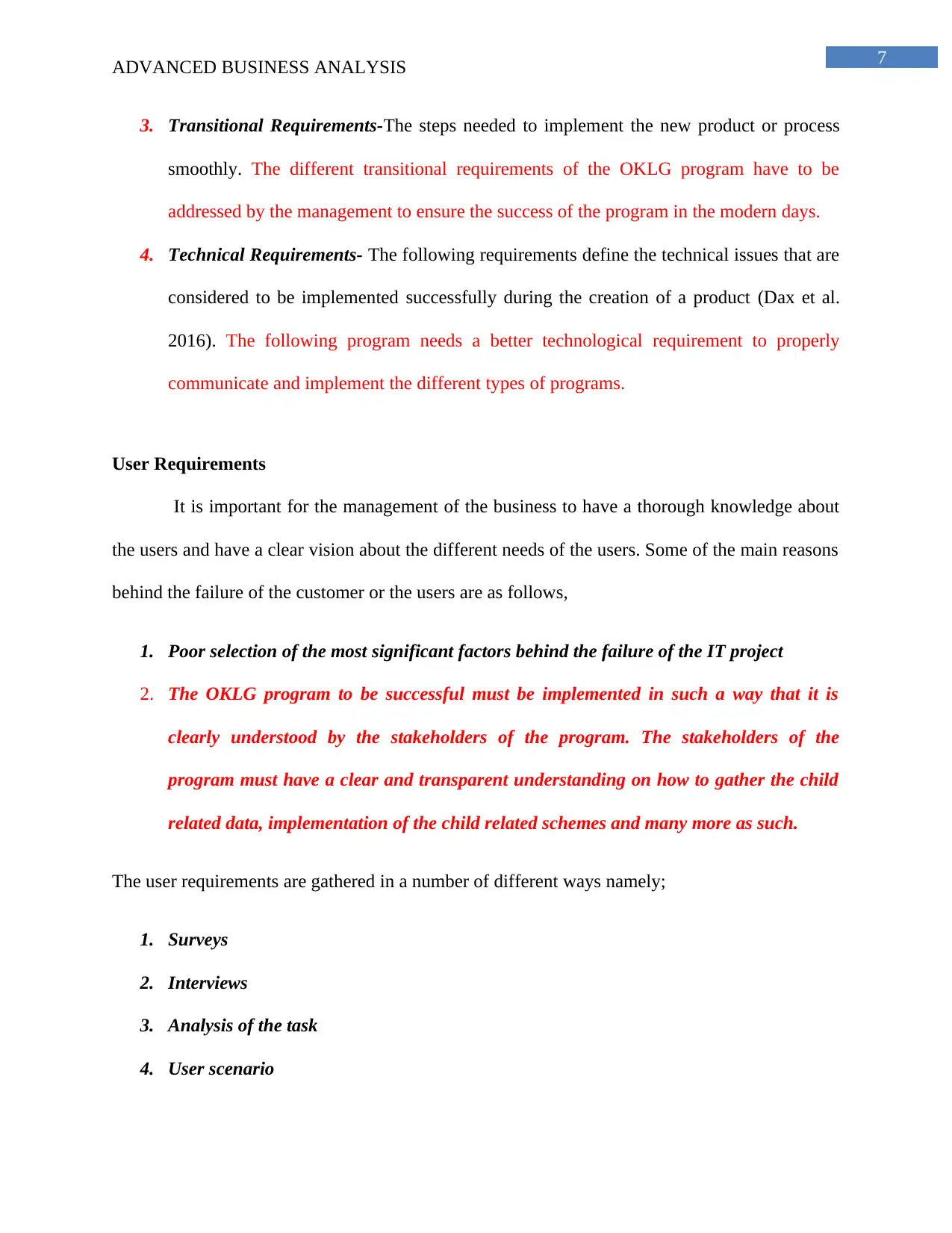
7
ADVANCED BUSINESS ANALYSIS
3. Transitional Requirements-The steps needed to implement the new product or process
smoothly. The different transitional requirements of the OKLG program have to be
addressed by the management to ensure the success of the program in the modern days.
4. Technical Requirements- The following requirements define the technical issues that are
considered to be implemented successfully during the creation of a product (Dax et al.
2016). The following program needs a better technological requirement to properly
communicate and implement the different types of programs.
User Requirements
It is important for the management of the business to have a thorough knowledge about
the users and have a clear vision about the different needs of the users. Some of the main reasons
behind the failure of the customer or the users are as follows,
1. Poor selection of the most significant factors behind the failure of the IT project
2. The OKLG program to be successful must be implemented in such a way that it is
clearly understood by the stakeholders of the program. The stakeholders of the
program must have a clear and transparent understanding on how to gather the child
related data, implementation of the child related schemes and many more as such.
The user requirements are gathered in a number of different ways namely;
1. Surveys
2. Interviews
3. Analysis of the task
4. User scenario
ADVANCED BUSINESS ANALYSIS
3. Transitional Requirements-The steps needed to implement the new product or process
smoothly. The different transitional requirements of the OKLG program have to be
addressed by the management to ensure the success of the program in the modern days.
4. Technical Requirements- The following requirements define the technical issues that are
considered to be implemented successfully during the creation of a product (Dax et al.
2016). The following program needs a better technological requirement to properly
communicate and implement the different types of programs.
User Requirements
It is important for the management of the business to have a thorough knowledge about
the users and have a clear vision about the different needs of the users. Some of the main reasons
behind the failure of the customer or the users are as follows,
1. Poor selection of the most significant factors behind the failure of the IT project
2. The OKLG program to be successful must be implemented in such a way that it is
clearly understood by the stakeholders of the program. The stakeholders of the
program must have a clear and transparent understanding on how to gather the child
related data, implementation of the child related schemes and many more as such.
The user requirements are gathered in a number of different ways namely;
1. Surveys
2. Interviews
3. Analysis of the task
4. User scenario
Paraphrase This Document
Need a fresh take? Get an instant paraphrase of this document with our AI Paraphraser
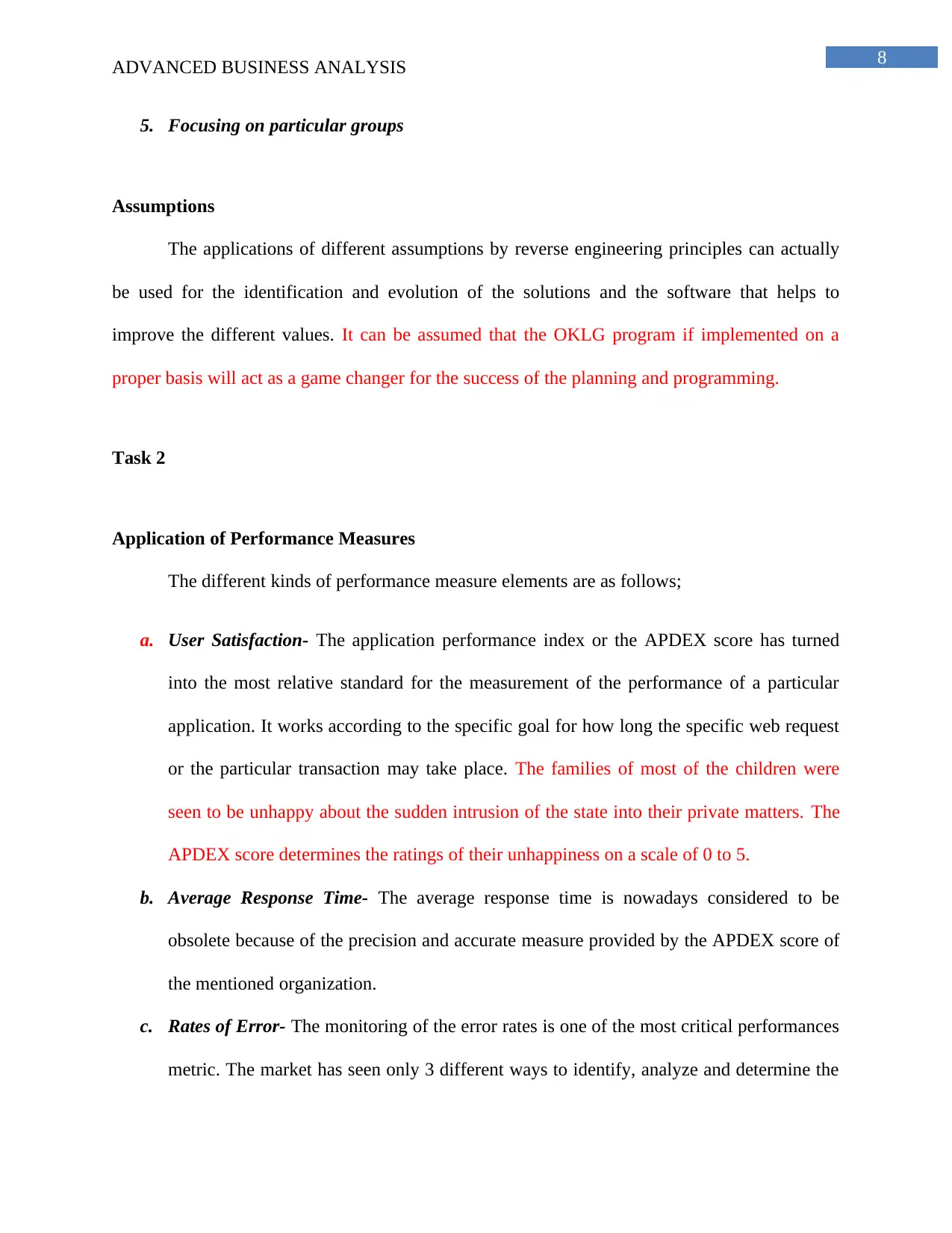
8
ADVANCED BUSINESS ANALYSIS
5. Focusing on particular groups
Assumptions
The applications of different assumptions by reverse engineering principles can actually
be used for the identification and evolution of the solutions and the software that helps to
improve the different values. It can be assumed that the OKLG program if implemented on a
proper basis will act as a game changer for the success of the planning and programming.
Task 2
Application of Performance Measures
The different kinds of performance measure elements are as follows;
a. User Satisfaction- The application performance index or the APDEX score has turned
into the most relative standard for the measurement of the performance of a particular
application. It works according to the specific goal for how long the specific web request
or the particular transaction may take place. The families of most of the children were
seen to be unhappy about the sudden intrusion of the state into their private matters. The
APDEX score determines the ratings of their unhappiness on a scale of 0 to 5.
b. Average Response Time- The average response time is nowadays considered to be
obsolete because of the precision and accurate measure provided by the APDEX score of
the mentioned organization.
c. Rates of Error- The monitoring of the error rates is one of the most critical performances
metric. The market has seen only 3 different ways to identify, analyze and determine the
ADVANCED BUSINESS ANALYSIS
5. Focusing on particular groups
Assumptions
The applications of different assumptions by reverse engineering principles can actually
be used for the identification and evolution of the solutions and the software that helps to
improve the different values. It can be assumed that the OKLG program if implemented on a
proper basis will act as a game changer for the success of the planning and programming.
Task 2
Application of Performance Measures
The different kinds of performance measure elements are as follows;
a. User Satisfaction- The application performance index or the APDEX score has turned
into the most relative standard for the measurement of the performance of a particular
application. It works according to the specific goal for how long the specific web request
or the particular transaction may take place. The families of most of the children were
seen to be unhappy about the sudden intrusion of the state into their private matters. The
APDEX score determines the ratings of their unhappiness on a scale of 0 to 5.
b. Average Response Time- The average response time is nowadays considered to be
obsolete because of the precision and accurate measure provided by the APDEX score of
the mentioned organization.
c. Rates of Error- The monitoring of the error rates is one of the most critical performances
metric. The market has seen only 3 different ways to identify, analyze and determine the
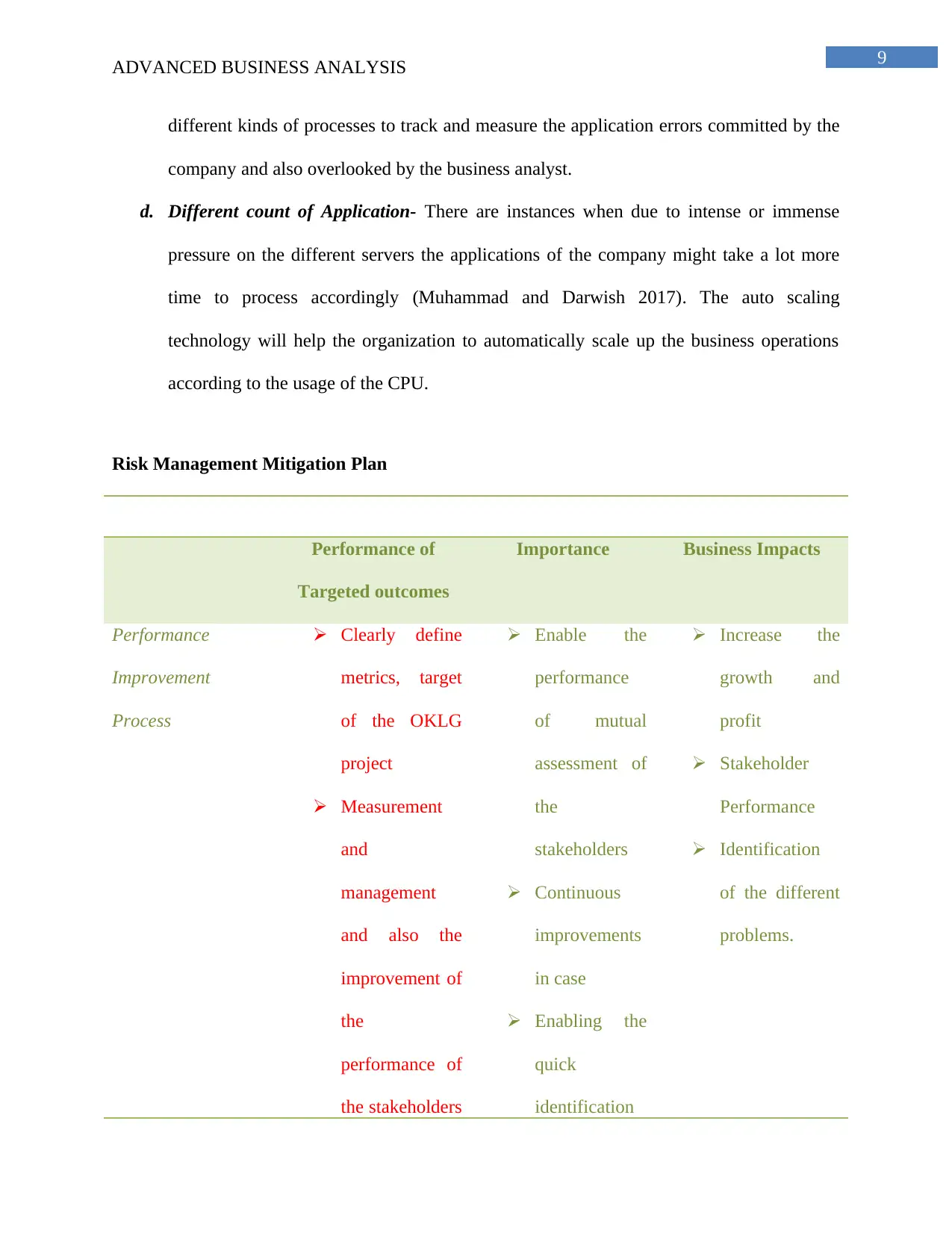
9
ADVANCED BUSINESS ANALYSIS
different kinds of processes to track and measure the application errors committed by the
company and also overlooked by the business analyst.
d. Different count of Application- There are instances when due to intense or immense
pressure on the different servers the applications of the company might take a lot more
time to process accordingly (Muhammad and Darwish 2017). The auto scaling
technology will help the organization to automatically scale up the business operations
according to the usage of the CPU.
Risk Management Mitigation Plan
Performance of
Targeted outcomes
Importance Business Impacts
Performance
Improvement
Process
Clearly define
metrics, target
of the OKLG
project
Measurement
and
management
and also the
improvement of
the
performance of
the stakeholders
Enable the
performance
of mutual
assessment of
the
stakeholders
Continuous
improvements
in case
Enabling the
quick
identification
Increase the
growth and
profit
Stakeholder
Performance
Identification
of the different
problems.
ADVANCED BUSINESS ANALYSIS
different kinds of processes to track and measure the application errors committed by the
company and also overlooked by the business analyst.
d. Different count of Application- There are instances when due to intense or immense
pressure on the different servers the applications of the company might take a lot more
time to process accordingly (Muhammad and Darwish 2017). The auto scaling
technology will help the organization to automatically scale up the business operations
according to the usage of the CPU.
Risk Management Mitigation Plan
Performance of
Targeted outcomes
Importance Business Impacts
Performance
Improvement
Process
Clearly define
metrics, target
of the OKLG
project
Measurement
and
management
and also the
improvement of
the
performance of
the stakeholders
Enable the
performance
of mutual
assessment of
the
stakeholders
Continuous
improvements
in case
Enabling the
quick
identification
Increase the
growth and
profit
Stakeholder
Performance
Identification
of the different
problems.
⊘ This is a preview!⊘
Do you want full access?
Subscribe today to unlock all pages.

Trusted by 1+ million students worldwide
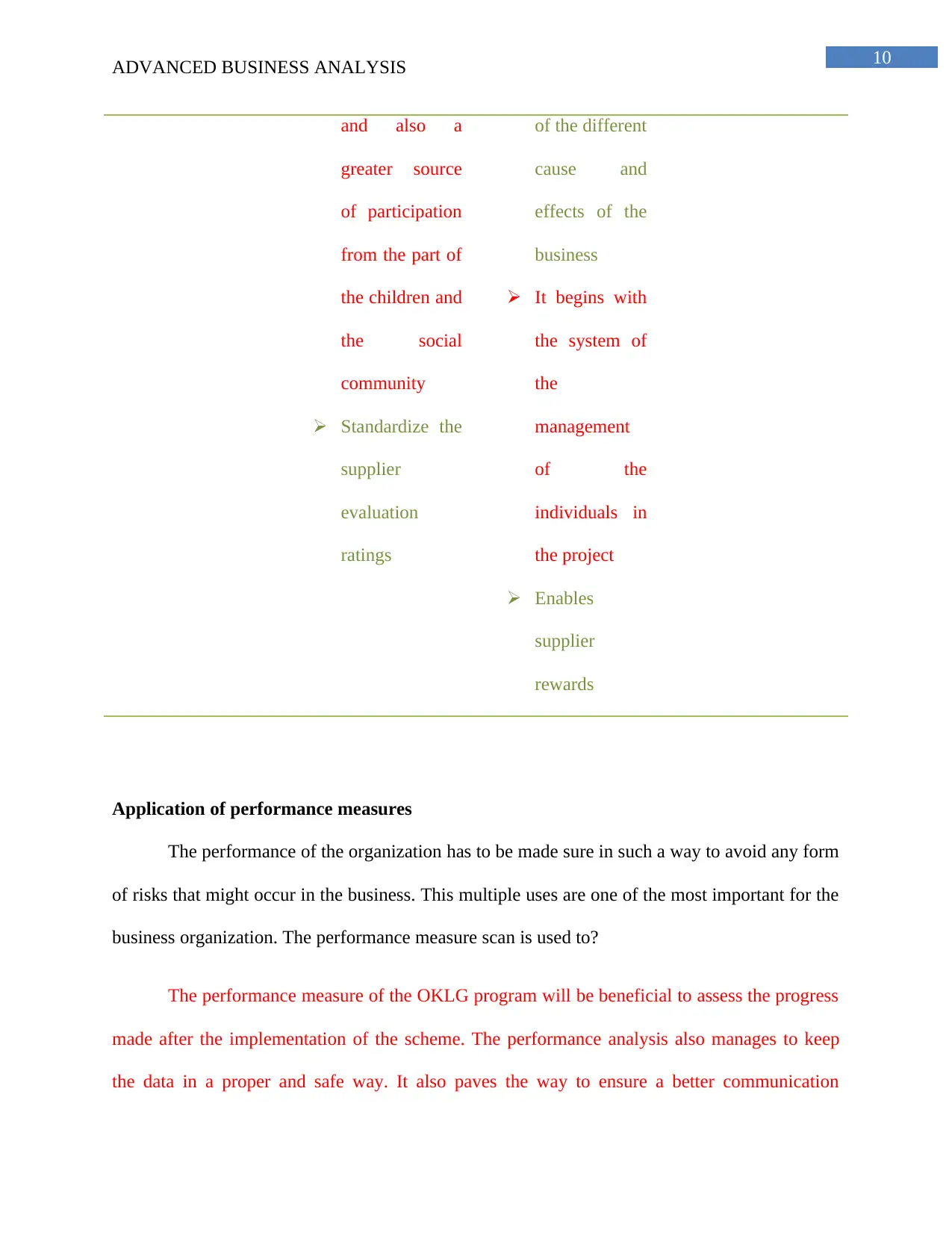
10
ADVANCED BUSINESS ANALYSIS
and also a
greater source
of participation
from the part of
the children and
the social
community
Standardize the
supplier
evaluation
ratings
of the different
cause and
effects of the
business
It begins with
the system of
the
management
of the
individuals in
the project
Enables
supplier
rewards
Application of performance measures
The performance of the organization has to be made sure in such a way to avoid any form
of risks that might occur in the business. This multiple uses are one of the most important for the
business organization. The performance measure scan is used to?
The performance measure of the OKLG program will be beneficial to assess the progress
made after the implementation of the scheme. The performance analysis also manages to keep
the data in a proper and safe way. It also paves the way to ensure a better communication
ADVANCED BUSINESS ANALYSIS
and also a
greater source
of participation
from the part of
the children and
the social
community
Standardize the
supplier
evaluation
ratings
of the different
cause and
effects of the
business
It begins with
the system of
the
management
of the
individuals in
the project
Enables
supplier
rewards
Application of performance measures
The performance of the organization has to be made sure in such a way to avoid any form
of risks that might occur in the business. This multiple uses are one of the most important for the
business organization. The performance measure scan is used to?
The performance measure of the OKLG program will be beneficial to assess the progress
made after the implementation of the scheme. The performance analysis also manages to keep
the data in a proper and safe way. It also paves the way to ensure a better communication
Paraphrase This Document
Need a fresh take? Get an instant paraphrase of this document with our AI Paraphraser

11
ADVANCED BUSINESS ANALYSIS
existing between the different shareholders and other concerned members of the project and
makes the work coordinated and easy to manage.
ADVANCED BUSINESS ANALYSIS
existing between the different shareholders and other concerned members of the project and
makes the work coordinated and easy to manage.
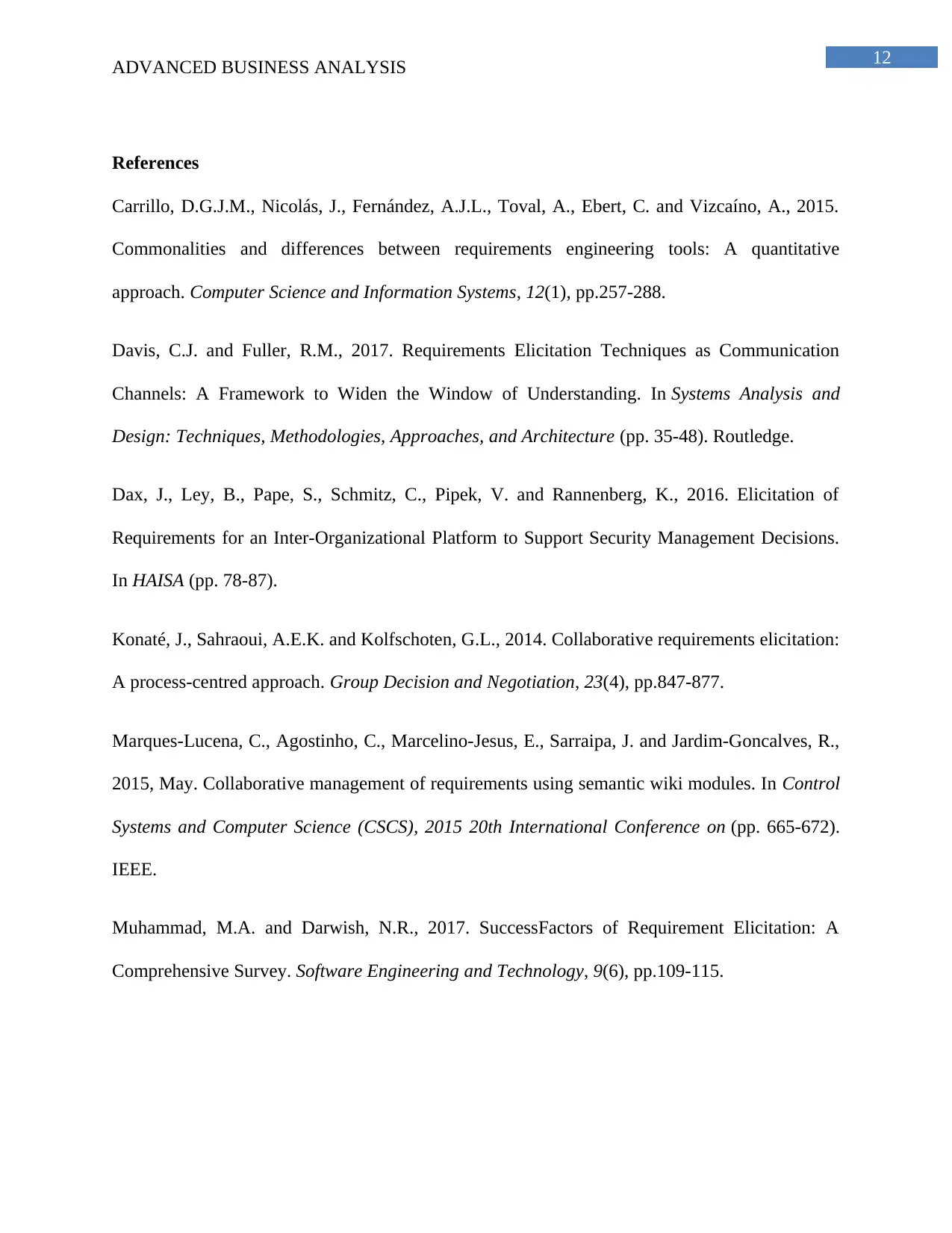
12
ADVANCED BUSINESS ANALYSIS
References
Carrillo, D.G.J.M., Nicolás, J., Fernández, A.J.L., Toval, A., Ebert, C. and Vizcaíno, A., 2015.
Commonalities and differences between requirements engineering tools: A quantitative
approach. Computer Science and Information Systems, 12(1), pp.257-288.
Davis, C.J. and Fuller, R.M., 2017. Requirements Elicitation Techniques as Communication
Channels: A Framework to Widen the Window of Understanding. In Systems Analysis and
Design: Techniques, Methodologies, Approaches, and Architecture (pp. 35-48). Routledge.
Dax, J., Ley, B., Pape, S., Schmitz, C., Pipek, V. and Rannenberg, K., 2016. Elicitation of
Requirements for an Inter-Organizational Platform to Support Security Management Decisions.
In HAISA (pp. 78-87).
Konaté, J., Sahraoui, A.E.K. and Kolfschoten, G.L., 2014. Collaborative requirements elicitation:
A process-centred approach. Group Decision and Negotiation, 23(4), pp.847-877.
Marques-Lucena, C., Agostinho, C., Marcelino-Jesus, E., Sarraipa, J. and Jardim-Goncalves, R.,
2015, May. Collaborative management of requirements using semantic wiki modules. In Control
Systems and Computer Science (CSCS), 2015 20th International Conference on (pp. 665-672).
IEEE.
Muhammad, M.A. and Darwish, N.R., 2017. SuccessFactors of Requirement Elicitation: A
Comprehensive Survey. Software Engineering and Technology, 9(6), pp.109-115.
ADVANCED BUSINESS ANALYSIS
References
Carrillo, D.G.J.M., Nicolás, J., Fernández, A.J.L., Toval, A., Ebert, C. and Vizcaíno, A., 2015.
Commonalities and differences between requirements engineering tools: A quantitative
approach. Computer Science and Information Systems, 12(1), pp.257-288.
Davis, C.J. and Fuller, R.M., 2017. Requirements Elicitation Techniques as Communication
Channels: A Framework to Widen the Window of Understanding. In Systems Analysis and
Design: Techniques, Methodologies, Approaches, and Architecture (pp. 35-48). Routledge.
Dax, J., Ley, B., Pape, S., Schmitz, C., Pipek, V. and Rannenberg, K., 2016. Elicitation of
Requirements for an Inter-Organizational Platform to Support Security Management Decisions.
In HAISA (pp. 78-87).
Konaté, J., Sahraoui, A.E.K. and Kolfschoten, G.L., 2014. Collaborative requirements elicitation:
A process-centred approach. Group Decision and Negotiation, 23(4), pp.847-877.
Marques-Lucena, C., Agostinho, C., Marcelino-Jesus, E., Sarraipa, J. and Jardim-Goncalves, R.,
2015, May. Collaborative management of requirements using semantic wiki modules. In Control
Systems and Computer Science (CSCS), 2015 20th International Conference on (pp. 665-672).
IEEE.
Muhammad, M.A. and Darwish, N.R., 2017. SuccessFactors of Requirement Elicitation: A
Comprehensive Survey. Software Engineering and Technology, 9(6), pp.109-115.
⊘ This is a preview!⊘
Do you want full access?
Subscribe today to unlock all pages.

Trusted by 1+ million students worldwide
1 out of 14
Related Documents
Your All-in-One AI-Powered Toolkit for Academic Success.
+13062052269
info@desklib.com
Available 24*7 on WhatsApp / Email
![[object Object]](/_next/static/media/star-bottom.7253800d.svg)
Unlock your academic potential
Copyright © 2020–2025 A2Z Services. All Rights Reserved. Developed and managed by ZUCOL.



